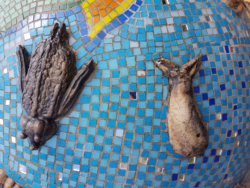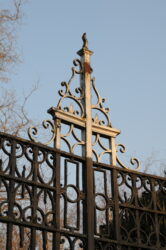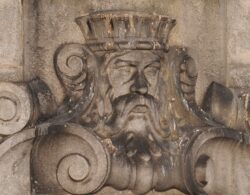Date/Time
Date(s) - Monday 11 April 2022
8:00 pm - 9:00 pm
Location
Duke Street Church
Categories No Categories


 This talk, researched by Shirley Newton and Shirley Clark, and delivered by Shirley Newton, was held at Duke Street Church, Richmond and was also streamed via Zoom. A report by RLHS member Chris Lynch appears below.
This talk, researched by Shirley Newton and Shirley Clark, and delivered by Shirley Newton, was held at Duke Street Church, Richmond and was also streamed via Zoom. A report by RLHS member Chris Lynch appears below.
Long-term residents of Kew, Shirley Newton and Shirley Clark explored some of the sculptures and monuments which are to be found locally as well as linking to some in other parts of the borough – from the old to the modern, from those in plain sight to those more hidden.
They revealed the sculptures’ form and function, the history surrounding them and the craftspeople who made them, along with some of their stories.
Shirley Newton
As a lifelong student of history, Shirley has always been fascinated by how the past and present intermingle in the local environment. From this, and from discussions with Shirley Clark, the idea for this talk was formed.
Shirley Clark
Inspired by a talk by Art UK on the recording of public art, Shirley became a volunteer researcher for their latest project, compiling a database of public sculpture in the UK. Her interest in local sculpture was sparked by this, and from lockdown walks around the borough.
Christopher Lynch reports on Shirley Newton & Shirley Clark’s talk
Kew’s identity emerges from the habitation of its geography and the officially sanctioned inscriptions arising from its long and significant history. Over centuries, many arts and trades have insinuated themselves into Kew’s distinctive material culture, not least amongst them the labours of the sculptor. Just as Art UK aims to foreground the presence of public art nationally, Shirley Newton and Shirley Clark aim to foreground the presence of public sculptures locally.
Shirley Newton presented their joint research, research organised to enrich Richmond Local History Society members’ enjoyment and understanding of how local public spaces have been fashioned as expressions of power; of public utility; of military and civilian commemoration; of historical and geographic legacies and how new millennium sculptures are forging new identities.
Some of the newest sculptures evoke the oldest histories. Mark Folds’ Cayho (2000) at Kew Pier and Simon Packard’s Liquidity (2002) on the Brentford bank celebrate the centuries-old fishing industry along this stretch of the Thames. Although thematically similar their scale and materials differ. Cayho, the Anglo-Saxon name for Kew, is play-park size, inviting children to journey through its keyhole of Portland stone. Liquidity is a highly reflective stainless-steel sculpture, charting the mobility of light from the fish-rich river, its six by nine metres dimensions a necessary condition of its expansive visual display.
While Kew is home to many of us it is also located en route to the metropolis by road and by river. Shirley shared a fascinating page detail from Paterson’s Road Book of 1822 showing the main road west of London through Turnham Green and Brentford. Three hundred years before satnavs the branch road (now Kew Road) was articulated with milestones informing road users in the early 18th century of their distances from Hyde Park Corner. Their installation probably dated from the first Kew Bridge, given the connecting route this enabled to the main west road.
Royalty and attendant aristocratic households began to be attracted to Kew from as early as the 14th century. Wherever the monarch was situated, his or her authority was primary and land ownership expressed power. It was not until the 1840s that the public were allowed controlled and limited access to Kew Gardens. The public entrances to the gardens then became sites declaring royal largesse even while being funded from the Exchequer.
Coade stone’s chemistry delivered durability and enabled its manufacturers to carve delicate ornament into its sculptures. Two prominent examples are the Lion and Unicorn sculptures, each expressing medieval symbols of royal power. The Lion still marks one of the botanic garden’s principal entrances. Some might think that there is a parallel in Coade stone’s mimicking of natural stone with the financing of royal power from the public exchequer while others celebrate ingenuity and continuity respectively.
We are all familiar with Victoria Gate, Lion Gate, Elizabeth Gate and, for those with a longer visiting history, Cumberland Gate but less so with the history of British design and manufactory creating these wonderful artefacts.
In the talk we learned about the Lambeth Coade Factory located on what was to become the main Festival of Britain site; about Walkers of Rotherham and the work of Decimus Burton.
Kew is enshrined in memories. In the early decades of the 20th century North Sheen Cemetery (1906) and Mortlake Cemetery (1926) were established on what had been farmland. The consequences of two world wars scarring the first half of the last century are inscribed in memorials to the military and civilian dead. Prior to the Great War, soldiers who died on the battlefield were buried in individual graves but the carnage of the nation’s youth changed the public mood towards more formal commemoration. And this is recognised amongst other examples in Kew Green’s Cross of Sacrifice memorial and the Gardens of Remembrance within Mortlake Cemetery.
The artistic practice of remembering death is obviously much older than a hundred years as a stroll around St Anne’s Church soon reveals. One very fine example near the tombs of Thomas Gainsborough, Johan Zoffany and Sir William Hooker is the tomb of William Aiton, gardener to George III. The unfussy plainness of its distinctive shape in death was said to have reflected the plainness of William’s manners in life.
Achieving distinction as new phases of housing populate Kew’s built-scape is no easy matter. One means though is through public sculptures. William Pye’s water sculpture Miss Prism functions as a zen-like metonym representing Kew Riverside’s contemporary peacefulness. The elongated elegance of Danny Lane’s Eccentric Empress fits the pedestrian ease of Melliss Avenue’s pathways while John Gibbons’ White Light Passage in Whitcombe Mews articulates the near proximity and movement of the river’s colours.
This talk began with combining the ancient with the modern and so it concludes. Contained within The National Archives at Kew is a treasure trove of historical data, and marking its external environs are sculptures and gates bespeaking this same theme. Allan Evans’ gate design is informed by the shape and function of medieval tally sticks. The notches on the sticks were early forms of tax accounting. An incidental point, Shirley shared with us, was that the burning of tally sticks stored within the Palace of Westminster was instrumental in its 1834 fire. Resistant to any normal conflagration today are the oxidised steel sculptures with their pen nib highlights and sorting office paraphernalia.
Those who attended Shirley Newton and Shirley Clark’s presentation will now be able to traverse Kew’s public spaces with new eyes.
